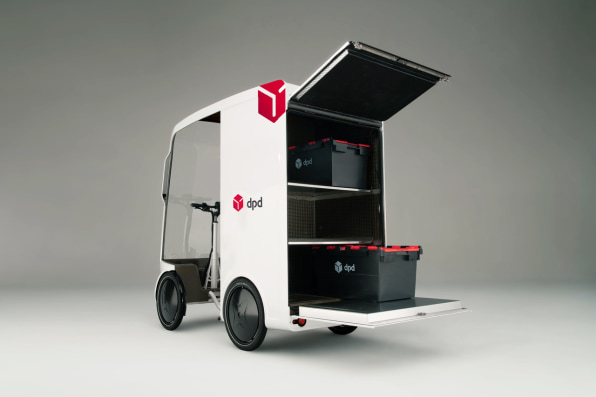
By Katharine Schwab
In the rush to get packages to your doorstep faster, delivery companies are experimenting with far-out technologies like drones and robots that can circumvent traffic—and that, most importantly, don’t need a conventional place to park while they deliver. But companies like UPS and the U.K.-based company DPD are considering a low-tech option, too: bikes.
DPD is rolling out a pilot program that uses cargo e-bikes that don’t resemble traditional bikes at all. Instead, DPD’s bike looks like a mini truck, but it’s small enough to fit inside the bike lane in London, where it’s starting to make deliveries in the city’s ultra low-emissions zone, where vehicles that don’t meet very strict emissions regulations have to pay a toll. Part of DPD’s aim with the project is to reduce its emissions to comply with regulations, while also making the city a more pleasant place for pedestrians.
The mini e-truck was developed by a startup called Eav and designed by the transportation design studio New Territory, which has previously worked on autonomous car concepts and Airbus’s ambitious modular airplane project Transpose. Unlike other cargo e-bikes like the ones that UPS is currently testing in Seattle, which look basically like a bike that’s towing a little trailer, Eav’s vehicles have four wheels, which are supposed to provide extra stability while maintaining the same delivery truck look that people are used to.
“It has the aesthetic of vehicles we know,” says Luke Miles, the cofounder and creative director at New Territory who led the industrial design for the vehicle. But it was designed to be more approachable: “The person who’s operating it is brought more closely to the person on the street, there’s less of a barrier.”
Additionally, the design provides full cover for the driver, with a windshield and roof to help keep out rain and wind (crucial for an operator based out of London). The sides of the vehicle remain open, like many of today’s delivery trucks, so the driver can easily pop in and out while running packages to people’s doors. The e-bike can carry up to 330 pounds and goes up to 15 miles per hour.
Bike deliveries are nothing new—in fact, they’ve been used for many decades, particularly in cities. It’s only in the last few decades, with the rise of large delivery companies like UPS and FedEx, that the large lumbering truck has become a fixture on city streets. According to Anne Goodchild, a professor and the founding director of the Supply Chain Transportation and Logistics program at the University of Washington, large trucks make sense in an older supply chain model, where you build large warehouses far outside cities and then truck packages in. “To some extent we have this assumption that the norm is this very big truck,” Goodchild says. “That hasn’t been the case forever.”
But as cities get more congested and it grows increasingly difficult for drivers to find a place to park the hulking vehicles, delivery companies are experimenting with other options. That means rethinking the warehouse model, too.
“This [faster] delivery actually requires changing the model and building more small warehouses close to people again,” Goodchild says. “If you’re not bringing it from far away, it’s very reasonable to start thinking about smaller vehicles that are more nimble, especially if you’re doing quick deliveries and they don’t need big huge quantities.”
That’s exactly what DPD is doing: The company opened a smaller warehouse in the Westminster area of London in October where the mini e-bike trucks, as well as other smaller electric vehicles in the company’s fleet, can pick up packages. So far, the change has resulted in a 49% reduction in miles driven per package, and by switching to electric vehicles in the London city center the company has reduced emissions by a rate of nearly 50 tons of carbon dioxide per year.
“I think the average speed of travel inside London is slow, so we can use bike lanes to move around more efficiently in the city center,” says Rob Fowler, general manager for technical planning at DPD. “It’s very carefully designed to be compliant in these bike lanes. We wanted to make sure we can move around the city as efficiently as possible without putting more congestion on the roads.”
DPD is planning to scale up this new delivery model to other dense areas in the U.K.
However, there’s one problem with using the bike lane as a way to deliver packages: E-bikes like this one could be dangerous for cyclists, who aren’t used to larger cargo bikes like this taking up so much space or stopping to drop off packages. Cargo e-bikes probably shouldn’t be stopping in the bike lane at all, and instead be parked, which should be relatively easy given their small size. DPD says it is currently working on a way to train riders to make sure they use the cargo bike safely, including pulling out of the bike lane for unloading.
This issue is part of the reason Goodchild is working with the city of Seattle, where UPS is currently piloting its own cargo e-bike program: to understand the impact of this type of delivery on the rest of the people on the street.
“Because the existing rules have really been set up for single bikes, not bikes with trailers, and without e-bikes in mind, I think it’s a bit of a gamble right now,” Goodchild says. “What are the effects of that on other users? It’s important to do this research, because otherwise we’re just speculating.”